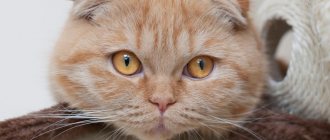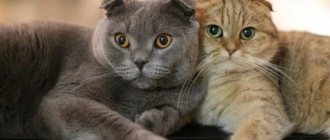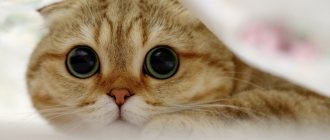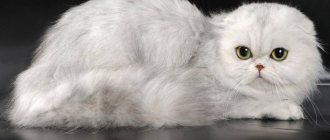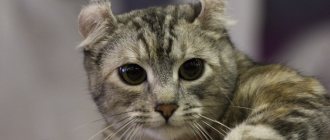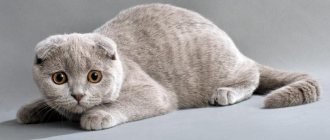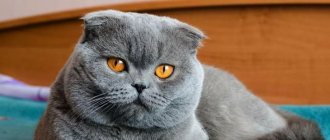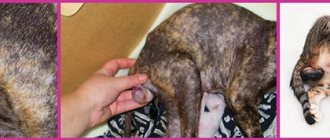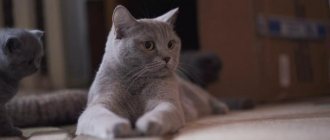Origin story
The only significant difference between Scottish Straight cats and Scottish Fold cats is in the ears.
They are not curved, but straight - that’s the whole difference. These cats appeared in the 60s of the last century on an ordinary Scottish farm, and initially the cats’ ears were folded. Breeders, having started breeding a new breed, quickly found out: in litters, both kittens with curled ears and normal ones are usually born, and in addition, the gene responsible for the lop-eared gene negatively affects the health of animals. The cats' bones thickened, early osteochondrodysplasia appeared, and they died early. Through trial and error, it became clear: the best option for crossing is a cat with straight ears and a fold-eared cat.
The Scottish Straight breed was officially registered in 2004 and immediately became extremely popular.
A kitten not for breeding costs about 5,000 rubles (without documents) and 10,000 rubles with documents. Show-class specimens will cost 18-25 thousand rubles.
How much does a Scottish Fold kitten cost?
The cost of a kitten can vary from 3 to 15 thousand rubles, depending on the class, pedigree, prestige of the nursery and, of course, color. For example, Scottish straight chinchilla or ticked will cost more than white or blue.
You can buy a baby in specialized nurseries; there are more than enough of them in Russia. There you will be given a veterinary passport for the baby, which includes vaccinations, metrics, and advice on feeding and maintenance issues.
Experienced breeders do not recommend buying pets on the market, according to advertisements on the Internet. Of course, the animal will cost less, but in this case no one will give you a guarantee that it is healthy and purebred.
You can pick up your baby from the nursery no earlier than 2 months, since teddy bears cannot do without breastfeeding.
Standards
The weight of a Scottish Straight individual is 3-3.5 kg, rarely more.
| Standard | Description |
| Head | The shape of the skull is round, with convex cheeks and forehead. The cheekbones are clearly defined (more so in cats than in cats), the chin is strong. The whisker pads are oval and plump. The nose is short, with a wide bridge and no noticeable stop. |
| Eyes | Large, widely spaced. The iris can be any color. |
| Ears | Large, wide at the base and with rounded tips. The outside is abundantly pubescent, the inside is less, but lush panicles, hard and long, grow on the skin. |
| Torso | Muscular, long, large, but with soft smooth lines. The neck is muscular and short. |
| Limbs | Long, strong, with oval and elastic legs. |
| Tail | Long, dense, reaching the shoulder blades in length. |
| Wool | The coat is thick, dense, and plush to the touch. It can be either short or medium length. Undercoat is present. |
Serious defects are considered:
- turned out toes;
- cryptorchidism;
- creases on the tail;
- short tail;
- small eyes;
- explicit “stop”;
- flat forehead;
- too wide ears.
Weight table by month
The Scottish Straight weight gain graph is clearly demonstrated in the table by month.
| Age | Female (weight in kilograms) | Male |
| 1 month | 0.3-0.65 g | 0.45-0.75 g |
| 2 | 0.45-0.8 g | 0.8-1.6 |
| 3 | 1.25-1.7 | 1.3-2.4 |
| 4 | 1.7-2.35 | 2.1-3.8 |
| 5 | 2.25-3.1 | 2.45-4.2 |
| 6 | 2.3-3.5 | 3.1-5.5 |
| 8 | 2.9-4.3 | 3.4-6 |
| 10 | 3.1-4.6 | 4.2-7.2 |
| 1 year | 3.2-5.3 | 4.6-7.4 |
| 2 and older | 3.4-5.6 | 5.3-8.2 |
Breeding
For breeding, they buy a “breed” . Upon reaching maturity, it is crossed with the Scottish Fold. Then the kittens will be born healthy. Sexual maturity is reached at 10 months. But if an animal becomes pregnant, there is a high risk of miscarriage or death during childbirth. Therefore, they are bred for the first time after 2-3 heats. Cats are ready for this process already at 9 months.
The best time for mating is spring. Then the kittens are born healthy and have numerous offspring. Only Folds are suitable for crossing Scottish Strikes; other breeds are strictly prohibited. This can provoke the birth of sick offspring.
Before mating, standard vaccinations are given, helminthization is carried out, and treated against parasites. All these activities are carried out by a veterinarian and documented. For mating, the cat is brought home to the male, provided with a tray and food so that she does not get nervous. A cat may meet its partner aggressively. Then they give time to get used to the male. To do this, sometimes you have to leave it for a couple of days.
Colors
Basic shades (solid):
- Black (a little white wool is allowed, but brown or red is considered a defect).
- White (with amber or copper eyes, or multi-colored eyes).
- Gray (without other color inclusions or patterns).
- Red (patterns on the paws and forehead are allowed).
- Chocolate (plain).
- Lavender (lilac, with a light brown nose and copper-colored eyes).
- Blue (blue: kittens may have patterns on their fur and copper eyes).
- Cream (possible patterns on tail and paws).
- Cinnamon (paw pads and nose - pale pink).
- Faun (eyes are bright, rich copper or amber, nose and paw pads are beige-pink).
- Bicolor colors - an admixture of white on the limbs, belly, chest or face. These are harlequin, van, ticked, shaded, tabby.
In the photo there are Scottish Straight cats of popular colors: black, white, blue
Rare colors: chinchilla, tabby, smoky, color point, calico, tortoiseshell (classic).
When choosing a pet for home keeping, color is not important, but in exhibition activities it is of no small importance. The CFA, for example, does not recognize chocolate, lilac, point, or all colors with white spots.
Characteristics of the Scottish Fold breed (Scottish Fold)
In a nutshell, we can say that the genetics of Scots are theoretically quite simple: if one parent is fold-eared, there is a 50/50 chance of getting the same kittens. But practice shows that fewer lops are born than straights. You can recognize the sign of lop ears in kittens by about 5 weeks of age.
The Scottish Fold has relatively low maintenance and care requirements. This breed does not require special handling. To be happy, this breed requires a clean environment, plenty of food and, above all, the sympathy of its owners. Scottish Folds have a sense of humor and frolic when their owners play and laugh with him. His appearance alone already puts anyone in a good mood. The head of the Scottish Fold cat is well rounded, with a firm chin and well-developed jaws. The muzzle should have noticeable and well-rounded whisker pads. The head smoothly turns into a short, strong neck. The cheeks are well developed, especially in Scottish cats. The eyes are wide open. Large, round, widely set. Eye color generally matches coat color. The Scottish Fold has a wide nose with a slight transition. A small stop is acceptable, but a noticeable stop is considered a fault. The profile is soft, moderately streamlined. The ears are folded forward and down. Small, the smaller the better. Small, well-proportioned ears are preferred. The ears of a fold cat should be set in such a way as to emphasize the rounded skull. The tips of the ears should be rounded. The body is medium in size, rounded, in proportion to the level of the shoulders and croup. The cat is strong, densely built, but without a hint of fatness or lack of mobility due to short, rough limbs. The feet are very neat and well rounded, with five toes on the front feet and four on the hind feet. Scottish Fold cats can be slightly smaller than male cats. The tail is medium to long, but proportional to the body. The coat of the Scottish Fold is short, dense, plush, and uniform. Coat texture may vary depending on color or regional and seasonal variations. The length of the coat is medium-long to long. Abundant hair on the face and body is desirable, but short hair is allowed on the face and limbs. “Panties”, tail feathering, tufts of hair between toes and ear feathering should be clearly visible, a collar is desirable. A serious drawback of adult animals is cotton wool. The colors of the Scottish Fold can be divided into several conditional groups - solid (saturated - black, red, chocolate, lightened - blue, lilac, cream), tortoiseshell, smoky, chinchilla, patterned (tabby) and colored point In most cases, the eye color of Scottish cats should be orange or copper, but there are exceptions, for example, emerald or intense golden eyes of chinchillas and silver shaded colors, blue eyes in color point cats.
Character and behavior
Looking at the imposing and massive Scottish Straights, you might think that they are lazy and do not see beyond their food bowl. Not at all! Of course, among cats of this breed (as well as among individuals of other breeds) there are many phlegmatic animals, but not all have such a specific character. Scottish Straights are reasonable and careful, they look closely and think for a long time before taking on any business, but this does not mean at all that they are stupid or slow.
Scottish Straights can run as fast as their feline counterparts and love new toys and running around. They just need a little more rest and quiet. They are not hermits or beeches: Scottish Straights love to be the center of attention, but they also easily tolerate loneliness.
The peak of playfulness occurs in the first couple of years of their life; for the rest of the years, cats prefer a leisurely existence in comfort and coziness, next to their favorite representatives of the human race.
They are careful, restrained in expressing feelings, but affectionate and very patient. These are the same cats that you can have in a family with small children. Scottish will never allow himself to scratch a child or scare him with a loud hiss. If the cat is “pushed”, he will silently run away and hide, but will not take revenge. They are not vindictive or vindictive, and do not suffer from mood swings, but they can be very persistent and even obsessive. If they really want something, they will follow you on your heels and scream until victory.
Name the cat who always wanted to live together
BasilioLeopold
They respond well to learning basic skills - going to their litter box (How to train a kitten to use the litter box?), eating at certain hours, not stealing from the table - but training is not for them. They get along well with other cats and even dogs, but they do not like small animals.
A change of environment is difficult for them, as is moving. They are afraid of heights, loud sounds and do not like water.
Care instructions
Scottish straights are extremely clean. They carefully monitor the appearance of their coat and the length of their claws, so these points require minimal attention from you.
If the animal is very dirty, it should be bathed using cat shampoo, and during shedding, it should be combed not once a week, as usual, but 2-3 times. Buy a stable scratching post and place it in a visible place - the cat will quickly adapt to it.
But cats in captivity do not know how to clean their ears and teeth. So this is your task. The ears are wiped weekly with a cotton swab dipped in boiled water or chlorhexidine, and the teeth are brushed every 10-14 days using a special paste and a small toothbrush with soft bristles.
Expert opinion
Dusheba Vera Ivanovna
In 2010, she graduated from the Moscow State Academy of Veterinary Medicine named after K.I. Scriabin with honors, specializing in veterinary medicine. I regularly attend veterinary conferences, congresses, and webinars.
You cannot use human cosmetics and hygiene products, even children’s! The components included in your shower gel or children's toothpaste can cause disturbances in the gastrointestinal tract and even poisoning.
How to choose the right kitten
It will be difficult for a non-professional to determine the differences in these breeds at an early stage in the animal's life. Basically, everyone relies on the words of the breeder. But many people, unknowingly, want to adopt a British Fold. There is no such breed. It’s not worth chasing after some fairy-tale pet. Before making a choice in favor of one or another kitten, you should carefully familiarize yourself with the characteristics of their appearance, behavior, and possible health problems.
A self-respecting breeder will definitely offer to get acquainted with the pedigree and show the parents of the offspring. This should be taken more than carefully. For example, after 2004, mating of British and Scottish Fold breeds was officially prohibited. If the kitten’s mom and dad were born later and had similar crosses in their pedigree, then the breed is not pure. It is also not allowed to cross two fold-eared cats. Such seemingly small nuances can later become a serious problem:
- Changes in the appearance of kittens in future litters.
- Inability to participate in international exhibitions.
- Serious physical problems: from general weakness to skeletal mutations and incurable diseases.
Of course, such global negative moments happen quite rarely. But you shouldn’t take the risk and buy a kitten. Folds have a semi-lethal gene, so events can unfold in completely different scenarios.
Catering
The issue of feeding should be approached with all seriousness: you cannot feed a living creature with just anything.
Food that is fatty, over-salted, with artificial preservatives and dyes in its composition will not bring any benefit to your pet, but it can “add” the stomach, liver, and other organs literally once or twice. And not all food from your table is suitable for an animal, even if it is good for you.
Natural products
Digestion is significantly different between humans and cats. The first thing a cat needs is calcium, phosphorus and taurine.
- And these substances can only be obtained from raw meat, lean and fresh: beef, chicken, rabbit, turkey, veal, lamb. During heat treatment, calcium transforms into a form that is practically not absorbed by the body, and taurine completely disintegrates. Meat components (muscle meat, offal, meat bones) should make up 90% of the daily diet.
- 5-10% are vegetables. Pumpkin, carrots, asparagus, zucchini, green beans, cauliflower, broccoli, greens (parsley, dill): vegetables are boiled or stewed and mixed with cereals. Cats rarely eat raw food.
- Rice, millet, oatmeal, buckwheat, semolina and pearl barley porridge are allowed. You can feed your cat with them every other day. Porridge is cooked in plain water without adding sugar, salt or seasonings.
- Chicken and quail eggs can be given no more than 2 times a week. Quails are boiled and fed whole; chicken ones are given only the yolk.
- Fish - flounder, hake, trout, salmon, tuna, navaga, saury, mackerel, ivashi, burbot, tench, chum salmon, carp - contains easily digestible protein, omega-3 and omega-6, and vitamins. But there is practically no calcium there, which causes problems with the musculoskeletal system in Scottish Straight cats. Therefore, fish can be given in small pieces along with meat and no more than once a week. Lack of fish will not negatively affect your cat's health if you add fish oil to the food.
- Low-fat fermented milk products - sour cream, yogurt, fermented baked milk, cream, cottage cheese, unsalted hard cheese - can be given every day, preferably in the afternoon.
- Vitamin-mineral complex, dry yeast in tablets, spirulina, kelp, sprouted alfalfa are very useful and should also be included in the diet.
Potatoes, legumes, cocoa-containing products, juices, alcohol, citrus fruits, bones, flour products and baked goods are prohibited!
Clean water at a comfortable temperature should always be available! You cannot give your animal water directly from the tap: tap water contains bleach and other components hazardous to the cat’s health.
Recommended food
From industrial feeds, choose only super-premium and holistic feeds. Go Natural, Savarra, Wellness CORE - these foods are recommended by both breeders and veterinarians.
Below are recommended super-premium foods. Links with the names of the food are clickable, on them you can, within our website, get acquainted with the descriptions of the food and read reviews from owners of cats of the Scottish Straight breed.
| Holistic | Super premium | Super premium |
| Wildcat | Golosi | Karmy |
Diseases
The most common problems are:
- Discharge from the eyes. This is not necessarily a sign of an illness: it is often due to the specific structure of the skull and narrow tear ducts. If the discharge is clear or brown and odorless, there is nothing to worry about. But an admixture of yellow or red pus is a signal of a problem.
- Otitis, ear mites, fungus. If your pet constantly shakes its head and seems to be trying to get something out of its ear, take it to the vet. Maybe something got inside, maybe you scratched the delicate skin while cleaning, or maybe it’s due to the onset of a disease.
- Joint problems (eg osteochondrodysplasia). Over time, the bones become deformed, which is why the animal begins to experience difficulties when walking: it cannot fully straighten its paws, and it is difficult for it to jump.
- Urolithiasis disease. Castrated males are more likely to suffer from this disease. There may be several reasons: lack of vitamins, hormonal imbalance, severe cold, infection, poor diet. The animal begins to run around frequently, stops eating, becomes lethargic, licks itself frequently, and blood is visible in the urine.
- Excess body weight. Scottish Straight cats are prone to obesity, so their diet should be monitored especially carefully.
Expert opinion
Dusheba Vera Ivanovna
In 2010, she graduated from the Moscow State Academy of Veterinary Medicine named after K.I. Scriabin with honors, specializing in veterinary medicine. I regularly attend veterinary conferences, congresses, and webinars.
Whether or not to vaccinate your pet is up to each owner to decide for himself. But remember: you can bring pathogens into the house on your hands, clothes, and shoes. In this case, even thorough washing and disinfection of the premises may not save the animal from infection. Distemper, panleukopenia, calcivirosis, rabies are mortally dangerous and without vaccinations your beloved creature will face a painful death. In addition, without vaccinations you will not be able to take your cat abroad.
Health
Scottish Straights are distinguished by good health. When the kitten is 2 months old, it is vaccinated and wormed, even when there is no access to the street. Then vaccinations are given annually, treatment against helminths - every 6 months. This breed is predisposed to arthritis, arthrosis, osteochondrodysplasia, and ear diseases. The first signs of disease are lameness and decreased mobility.
Deformation of the legs gradually appears; the animal prefers to lie down all the time. Elderly people often develop pathologies of the genitourinary organs. Urolithiasis is more common in castrated animals and in obese animals; infection also becomes a provoking factor. Scottish Straights can develop hair loss, but alopecia is more common in pregnant cats.
